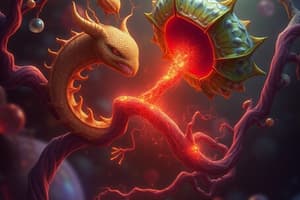Podcast
Questions and Answers
What is the main advantage of asexual reproduction?
What is the main advantage of asexual reproduction?
- Requires a mate
- Increased genetic diversity
- Fast reproduction rate (correct)
- Higher chances of extinction
Asexual reproduction produces offspring that are genetically identical to the parent.
Asexual reproduction produces offspring that are genetically identical to the parent.
True (A)
What is the process called where two gamete nuclei fuse together?
What is the process called where two gamete nuclei fuse together?
Fertilization
The fusion of gametes to form a ______ is called fertilization.
The fusion of gametes to form a ______ is called fertilization.
Match the following terms related to chromosomes with their descriptions:
Match the following terms related to chromosomes with their descriptions:
Which of the following is NOT a characteristic of wind-pollinated flowers?
Which of the following is NOT a characteristic of wind-pollinated flowers?
Self-pollination leads to genetic variation within a plant species.
Self-pollination leads to genetic variation within a plant species.
Which of the following is NOT an agent of pollination?
Which of the following is NOT an agent of pollination?
What is the role of the pollen tube in plant sexual reproduction?
What is the role of the pollen tube in plant sexual reproduction?
Self-pollination results in offspring with greater genetic variation compared to cross-pollination.
Self-pollination results in offspring with greater genetic variation compared to cross-pollination.
What is the function of the sepal in a flower?
What is the function of the sepal in a flower?
The ______ is the process where a pollen grain lands on the stigma and creates a tunnel down the style, through the micropyle to ovules.
The ______ is the process where a pollen grain lands on the stigma and creates a tunnel down the style, through the micropyle to ovules.
The process of ______ occurs when a pollen nucleus fuses with a nucleus in an ovule.
The process of ______ occurs when a pollen nucleus fuses with a nucleus in an ovule.
Match the following parts of a flower with their functions:
Match the following parts of a flower with their functions:
Match the following plant structures with their corresponding functions:
Match the following plant structures with their corresponding functions:
The pollen nucleus fuses with the female nucleus to form a zygote.
The pollen nucleus fuses with the female nucleus to form a zygote.
What are the three key factors required for seed germination?
What are the three key factors required for seed germination?
Cross-pollination can lead to increased susceptibility to diseases.
Cross-pollination can lead to increased susceptibility to diseases.
The male gamete is called a ______ in plants.
The male gamete is called a ______ in plants.
What is the role of the pollen tube in plant reproduction?
What is the role of the pollen tube in plant reproduction?
Which of these is NOT found in the male reproductive system of humans?
Which of these is NOT found in the male reproductive system of humans?
The transfer of pollen grains from the anther of a flower to the stigma of the same flower is called ______.
The transfer of pollen grains from the anther of a flower to the stigma of the same flower is called ______.
What is the main advantage of cross-pollination?
What is the main advantage of cross-pollination?
Flashcards
Asexual Reproduction
Asexual Reproduction
Production of genetically identical offspring from one parent.
Binary Fission
Binary Fission
A type of asexual reproduction where a bacterium divides into two identical cells.
Generation Time
Generation Time
The time taken for a cell to divide into two.
Sexual Reproduction
Sexual Reproduction
Signup and view all the flashcards
Fertilization
Fertilization
Signup and view all the flashcards
Haploid
Haploid
Signup and view all the flashcards
Diploid
Diploid
Signup and view all the flashcards
Pollination Differences
Pollination Differences
Signup and view all the flashcards
Pollination
Pollination
Signup and view all the flashcards
Self Pollination
Self Pollination
Signup and view all the flashcards
Cross-Pollination
Cross-Pollination
Signup and view all the flashcards
Anther
Anther
Signup and view all the flashcards
Stigma
Stigma
Signup and view all the flashcards
Ovary (in plants)
Ovary (in plants)
Signup and view all the flashcards
Enzymes in Germination
Enzymes in Germination
Signup and view all the flashcards
Testes
Testes
Signup and view all the flashcards
Ovary (in humans)
Ovary (in humans)
Signup and view all the flashcards
Germination
Germination
Signup and view all the flashcards
Ovary
Ovary
Signup and view all the flashcards
Uterus
Uterus
Signup and view all the flashcards
Study Notes
Asexual Reproduction
- Asexual reproduction produces genetically identical offspring from a single parent.
- Bacteria reproduce through binary fission, where one bacterium divides into two identical cells.
- Generation time is the time taken for a cell to divide.
- Advantages include speed and maintaining desirable characteristics.
- Disadvantages include lack of genetic diversity, making offspring susceptible to the same diseases and environmental changes.
Sexual Reproduction
- Sexual reproduction involves the fusion of two gametes (sex cells) to create a zygote, resulting in genetically unique offspring.
- Fertilization is the fusion of gamete nuclei.
- Gametes are haploid (half a set of chromosomes).
- Zygotes are diploid (full set of chromosomes).
- Advantages include genetic diversity, allowing quick adaptation to environmental changes.
- Disadvantages include time and energy involved as offspring are not identical to their parents, and the need to find a mate.
Flowering Plants - Reproduction
- Flowers are the reproductive organs of flowering plants.
- They usually contain both male and female reproductive parts.
- The structures of insect-pollinated and wind-pollinated flowers differ.
- Insect-pollinated flowers are often brightly colored and scented, with nectar and large pollen.
- Wind-pollinated flowers are often small, dull-colored, with a large volume of light pollen.
Functions of Parts of a Flower
- Sepals protect the flower bud.
- Petals attract pollinators.
- Anthers produce pollen grains (containing male gametes).
- Stigma is a platform for pollen to land.
- Ovary contains ovules that develop into seeds.
Pollination
- Pollination is the transfer of pollen from the anther to the stigma.
- Agents of pollination include insects, birds, mammals, water, and wind.
Self-Pollination vs. Cross-Pollination
- Self-pollination: pollen transferred to the same flower or another flower on the same plant.
- Cross-pollination: pollen transferred to a flower on a different plant of the same species.
- Advantages and disadvantages of each method are listed.
Fertilization in Plants
- Pollen tube grows and releases enzymes.
- Pollen tube reaches and then grows into the ovary.
- The pollen nucleus travels down the pollen tube to the ovule.
- Fertilisation occurs when the pollen nucleus fuses with the female nucleus.
- A zygote is formed and develops into a seed.
Germination
- Germination is the process controlled by enzymes.
- Water activates enzymes to convert insoluble food stores into soluble form.
- Oxygen is necessary for aerobic respiration.
- The required temperature ensures enzymes work optimally.
Sexual Reproduction in Humans - Male
- Testes produce sperm and testosterone.
- Scrotum holds testicles.
- Sperm duct carries sperm to the urethra.
- Prostate gland produces seminal fluid.
- Urethra carries semen to the tip of the penis.
- Penis is the male sex organ for transferring semen to the female.
Sexual Reproduction in Humans - Female
- Ovaries produce ova (eggs), progesterone, and estrogen.
- Oviduct (fallopian tube) carries the ovum to the uterus.
- Uterus is the site for fetal development.
- Cervix is the neck of the uterus with a small opening.
- Vagina receives the penis and is the birth canal.
Fertilisation and Early Development
- One sperm penetrates the ovum.
- The zygote forms, which divides, and grows.
- The zygote implants itself in the uterus wall.
- The fetus develops with the umbilical cord and placenta.
- The placenta facilitates exchange of nutrients and waste between the mother and fetus.
Adaptive Features of Gametes
- Sperm: small, elongated, streamlined, contains energy storage (mitochondria), and millions in number to have high chance of fertilizing the ovum.
- Ovum: larger, spherical with protective layer (jelly coat).
Sexual Hormones in Humans
- Hormones regulate secondary sexual characteristics during puberty.
- Primary sexual characteristics are present during development in the uterus.
- Secondary sexual characteristics include changes during puberty.
- Testosterone and estrogen play crucial roles in development and regulation of secondary sexual characteristics.
- The menstrual cycle involves the interplay of hormones (FSH, LH, estrogen, progesterone) in the ovaries and the uterus.
- The cycle has phases: menstruation, follicle maturing, ovulation, and the corpus luteum formation.
Studying That Suits You
Use AI to generate personalized quizzes and flashcards to suit your learning preferences.




